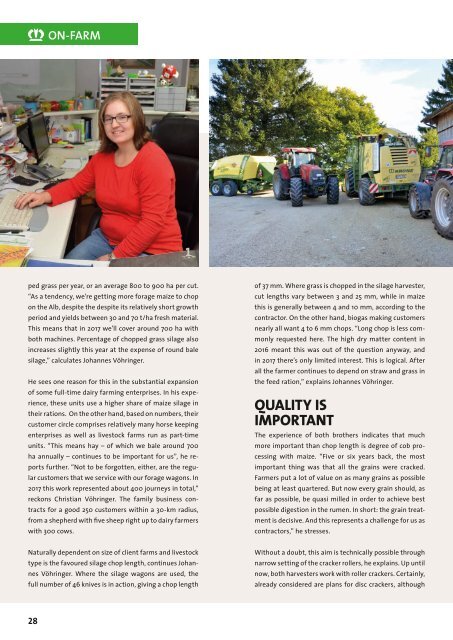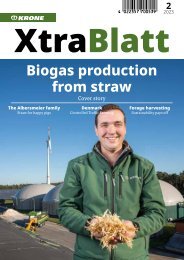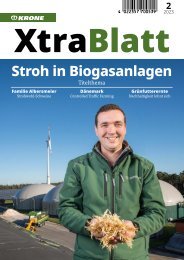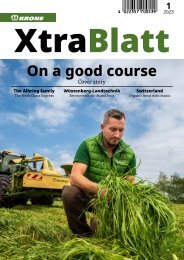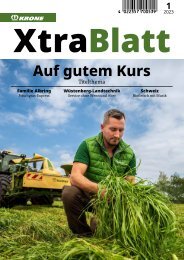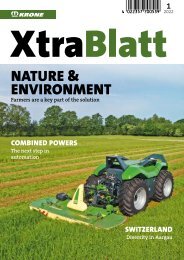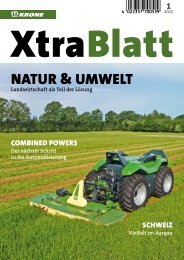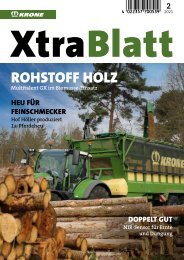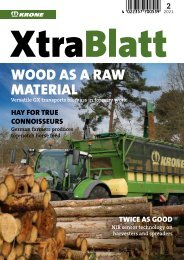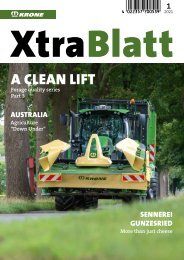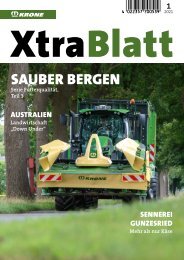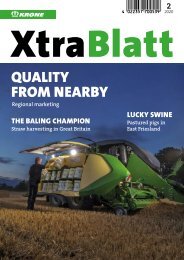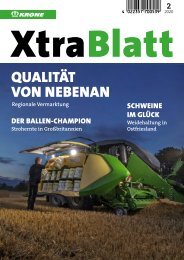XtraBlatt Issue 02-2017
Create successful ePaper yourself
Turn your PDF publications into a flip-book with our unique Google optimized e-Paper software.
MENSCHEN ON-FARM<br />
1<br />
ped grass per year, or an average 800 to 900 ha per cut.<br />
“As a tendency, we’re getting more forage maize to chop<br />
on the Alb, despite the despite its relatively short growth<br />
period and yields between 30 and 70 t/ha fresh material.<br />
This means that in <strong>2017</strong> we’ll cover around 700 ha with<br />
both machines. Percentage of chopped grass silage also<br />
increases slightly this year at the expense of round bale<br />
silage,” calculates Johannes Vöhringer.<br />
He sees one reason for this in the substantial expansion<br />
of some full-time dairy farming enterprises. In his experience,<br />
these units use a higher share of maize silage in<br />
their rations. On the other hand, based on numbers, their<br />
customer circle comprises relatively many horse keeping<br />
enterprises as well as livestock farms run as part-time<br />
units. “This means hay – of which we bale around 700<br />
ha annually – continues to be important for us”, he reports<br />
further. “Not to be forgotten, either, are the regular<br />
customers that we service with our forage wagons. In<br />
<strong>2017</strong> this work represented about 400 journeys in total,”<br />
reckons Christian Vöhringer. The family business contracts<br />
for a good 250 customers within a 30-km radius,<br />
from a shepherd with five sheep right up to dairy farmers<br />
with 300 cows.<br />
of 37 mm. Where grass is chopped in the silage harvester,<br />
cut lengths vary between 3 and 25 mm, while in maize<br />
this is generally between 4 and 10 mm, according to the<br />
contractor. On the other hand, biogas making customers<br />
nearly all want 4 to 6 mm chops. “Long chop is less commonly<br />
requested here. The high dry matter content in<br />
2016 meant this was out of the question anyway, and<br />
in <strong>2017</strong> there’s only limited interest. This is logical. After<br />
all the farmer continues to depend on straw and grass in<br />
the feed ration,” explains Johannes Vöhringer.<br />
QUALITY IS<br />
IMPORTANT<br />
The experience of both brothers indicates that much<br />
more important than chop length is degree of cob processing<br />
with maize. “Five or six years back, the most<br />
important thing was that all the grains were cracked.<br />
Farmers put a lot of value on as many grains as possible<br />
being at least quartered. But now every grain should, as<br />
far as possible, be quasi milled in order to achieve best<br />
possible digestion in the rumen. In short: the grain treatment<br />
is decisive. And this represents a challenge for us as<br />
contractors,” he stresses.<br />
Naturally dependent on size of client farms and livestock<br />
type is the favoured silage chop length, continues Johannes<br />
Vöhringer. Where the silage wagons are used, the<br />
full number of 46 knives is in action, giving a chop length<br />
Without a doubt, this aim is technically possible through<br />
narrow setting of the cracker rollers, he explains. Up until<br />
now, both harvesters work with roller crackers. Certainly,<br />
already considered are plans for disc crackers, although<br />
28


